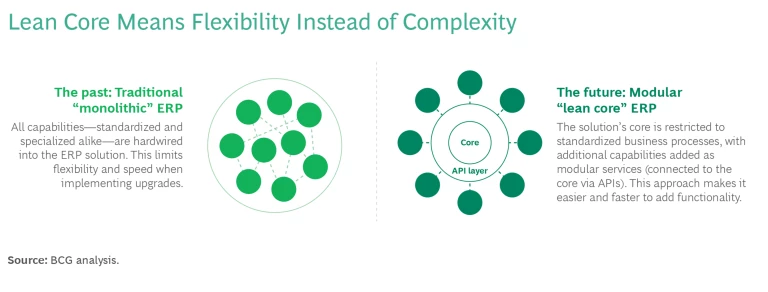For many companies, ERP transformations are like snowbirds in winter: they regularly head south. By our estimates, 50% to 70% of ERP programs fall short of their targets. Productivity doesn’t go up, transaction costs don’t go down, technical glitches and complexities abound. Yet the biggest problem isn’t quite so visible.
In a digital world, success means empowering people through technology. And that’s especially so today, as emerging tech like AI becomes more prevalent, more powerful, and more crucial for gaining competitive advantage. Savvy companies create that empowerment by reinventing processes to blend and maximize human and technical capabilities, sparking innovation and differentiation. But to this end, the traditional approach to ERP doesn’t help—it hinders.
There are a few reasons for this. First, the beauty of ERP—integrating processes and data from across the business—has also given rise to the bloat of ERP. Systems are often all-encompassing, with heavy customization that hardwires complex business flows and makes it hard to add new use cases, particularly in AI and personalization. Second, ERP projects tend to focus on technology. But true transformation is about people: understanding how they work and helping them use technology to create value.
New times call for a new approach to ERP, one designed around two key pillars: lean core ERP and human-centered design (HCD). It’s a model that fosters agility, flexibility, innovation, and value creation. But companies that embrace it create something else, too—a foundation for bringing out the best in their people as markets, needs, and opportunities evolve.
Flexibility Instead of Complexity
Companies typically view ERP through a technical lens. But an ERP transformation is a business transformation, and it calls for a value perspective. By modernizing their ERP in the right ways, companies can create value through four levers:
- Standardization. Out of the box, today’s ERP solutions capably and efficiently meet many business needs, particularly in areas like e-commerce and business intelligence. By opting for default processes as much as possible, organizations can avoid costly custom-coded configurations and save time and effort to boot.
- Harmonization. ERP modernization presents an opportunity to align processes and data models across the organization. This reduces the complexity, costs, and additional work—not to mention the potential for error—that arise when every department or function has its own way of getting things done.
- Differentiation. Sometimes it pays to think outside of the box. A distinctive capability or one that sparks operational excellence (for example, by employing AI to improve customer service or optimize supply chains) can give businesses a leg up on the competition. The trick is knowing where to focus the effort.
- Innovation. By leveraging emerging technologies and practices such as advanced analytics, AI, robotic process automation (RPA), and data transparency, companies can create value in multiple ways for both internal and external users. Chief among them: faster outcomes, more informed decision making, and improved communications and accountability.
Traditional ERP transformations unlock standardization and harmonization benefits, but perhaps not to the extent they could. When a project is technology focused, so too is the decision making. Where to embrace standard features? What to harmonize? ERP architects tend to base their answers on technical or cost-related drivers rather than a deep understanding of user needs. But roles and workflows are changing rapidly with the rise of AI, RPA, and other technologies. Without the user’s perspective, it’s hard to standardize and harmonize with pinpoint precision.
ERP bloat is another bar to successful transformation. When evolving capabilities (think AI and personalization) are tightly integrated into ERP, the result tends to be a monolithic platform that doesn’t play well with change. Companies don’t have the flexibility to upgrade those capabilities (or add new ones) quickly. They’re effectively locked into what the system can support and locked out of new opportunities. This makes it particularly hard to innovate and differentiate.
ERP transformations get harder still if organizations pay scant attention to human-centric needs and aspirations. A lack of insight around the user—understanding the end-to-end journeys and needs of employees, customers, and partners—hobbles an organization’s ability to focus in the right places and provide solutions that motivate and inspire.
So how do you pull all of the value levers and unlock the full potential of ERP transformation? By combining human-centered design and lean core ERP.
HCD puts the human perspective front and center, helping companies identify and focus design around user needs, behaviors, limitations, and capabilities.
HCD is an approach fostered by decades of academic research—and proven by a long array of successful products and services. It puts the human perspective front and center, helping companies identify and focus design around user needs, behaviors, limitations, and capabilities. HCD looks at its stakeholders’ end-to-end journeys and asks how they can be simpler, more seamless, more productive. It involves users throughout the process, from initial research through testing, sparking designs that are both useful and usable.
That’s a particularly compelling proposition for ERP. Many transformations disappoint because users struggle with the system and, ultimately, the adoption rate is lower than expected. The culprit isn’t always a poor user interface. Often, the problem is that the ERP system doesn’t align with—let alone facilitate—evolving roles, opportunities, and pathways. HCD provides insights that let companies reimagine their processes and map out new roles so users can meet their goals and aim even higher.
Lean core is a practice in which the heart of an ERP solution—its core—is focused solely on what ERP does best: running standardized business processes at scale with consistency and stability. These are the processes needed to run the business, but that don’t need to be implemented in a customized way (or at least, customization brings no significant advantage). The lean core approach minimizes complexity in the core and lowers upkeep costs.
Specialized ERP functions are loosely coupled to the core, so companies can create and expand them without worrying about complex integrations.
Of course, the heart doesn’t beat in isolation: it connects to vital organs. Similarly, the lean core connects to specialized, made-to-order ERP functions and experiences that differentiate, create value, and set the business apart. The idea is that instead of hardwiring these capabilities into a tightly integrated ERP solution, they’re built as modular business services, loosely coupled to the core via APIs. (See the exhibit.) This affords greater flexibility. A company can create, expand, and adapt these modules without worrying about complex integrations. There’s also more leeway in choosing the architecture and the technologies best suited for a specific task—for example, taking advantage of microservices and cloud-based functionality.

And crucially, lean core allows companies to innovate and differentiate at speed. Take, for instance, supply chain optimization. An algorithm for demand-supply optimization can be an important differentiation feature. But if it’s left within your ERP core, it can’t be easily changed. By implementing this feature outside the core, you can make enhancements more quickly, and with fewer constraints, so you can ensure that your optimization is always optimal.
Consider now how HCD and lean core function in unison. HCD shows you where to focus: the needs, challenges, and changes that matter most and the best ways to approach them. Lean core lets you respond and implement new capabilities quickly.
By combining lean core ERP and HCD, you can optimize the four value levers, but what you are really doing—and this is the crux of the approach—is reimagining ERP modernization as the cornerstone of a larger competitive transformation. You’re generating insight on new roles, new needs, new ways of doing business. And you’re leveraging that knowledge to empower your employees, customers, and partners.
Some points to keep in mind:
- The key to making lean core work is data liberation. This means decoupling data from legacy IT and isolated systems so that it becomes a separate layer in your tech stack. In effect, data is now an independent resource, more readily available to fuel AI algorithms, enhance decision-making, and generate insights that spark competitive advantage.
- It’s also crucial to know what to put in the core: what processes to include and what those processes should look like. Balance is important, too. If you put too many capabilities outside the core, you wind up with many modules to support (and control), and complexity—along with upkeep costs and effort—will start creeping up. HCD helps you get make the right decisions.
Three Mental Flips
In our work putting this approach into action, we’ve found that there’s one more essential ingredient: the right mindset. While many companies are well versed in the nuts and bolts of ERP, few have experience viewing, let alone reimagining, an ERP transition as a competitive transformation. But that viewpoint is vital for achieving superior results. And it’s particularly important that senior leaders embrace this perspective, as they’re in the best position to foster a culture for change.
How do you develop that mindset? Three mental flips—and the practices that make them stick—can help.
Instead of framing ERP transformation as a technology problem with outcomes that impact people, frame it as a people challenge with certain technology outcomes.
People, not technology, are at the heart of an ERP transformation. Instead of framing ERP transformation as a technology problem with outcomes that impact people, frame it as a people challenge with certain technology outcomes. This means focusing first on the human component. Involve end users from the start: understand their needs and behaviors and identify the gaps or roadblocks (in processes, journeys, and data access) that hinder them. Use the insights you gain to address these challenges, but also to determine where to prioritize, standardize, and harmonize—and where there is value in doing something unique. Only after you’ve developed your overall plan should you consider the technology you’ll need to make it work.
This people-first approach requires co-creation involving stakeholders from across the business. Bringing everyone together not only fuels a deep understanding of needs, behaviors, and roadblocks, but also increases adoption of the new solution. By breaking down the silos, you spark a collaborative, unified ERP transformation that works for and empowers your entire organization.
Human-centered design drives differentiation and innovation. Take a cue from digital leaders—and their success—and make customer centricity a mantra as you transform your ERP. Document user archetypes and personas, based on ethnographic research, so you can explore the end-to-end journeys of the key users—the true customers of the ERP solution. Test designs with users, from the very first prototype, so you can gauge the impact of ERP changes on everyday human experiences. By taking this approach, you can more easily spot problems, focus your effort in the right places, and launch solutions that are both on time and on point.
Successful transformations are underpinned by an end-to-end view of how people use data. Develop a deep understanding of how users consume data: how it flows and how people interact with it. This end-to-end view can serve as a catalyst and guide for improving data governance, prioritizing data requirements, and reengineering data processes.
It’s important to do this analysis at the start of the transformation process. You want to challenge the reasons for capturing different types of data, explore how users access and manipulate data, and understand who plays what role in ensuring quality. The human-centered approach is crucial here. Experience mapping based on personas, for example, can improve your understanding of how and where people use data. HCD can reveal why users may be paying insufficient attention to data quality and what steps you can take to change their behavior. And by testing new data interactions early and often, the HCD way, you can fine-tune your processes—and continually improve them.
ERP transformations have long put technology front and center. But it’s how people use technology that sparks, or hinders, success. By combining HCD and lean core ERP, you’re unleashing two powerful enablers: insight on how people can achieve their goals and flexibility in how you help them do so. You create experiences that unlock human potential—and new paths to value.




